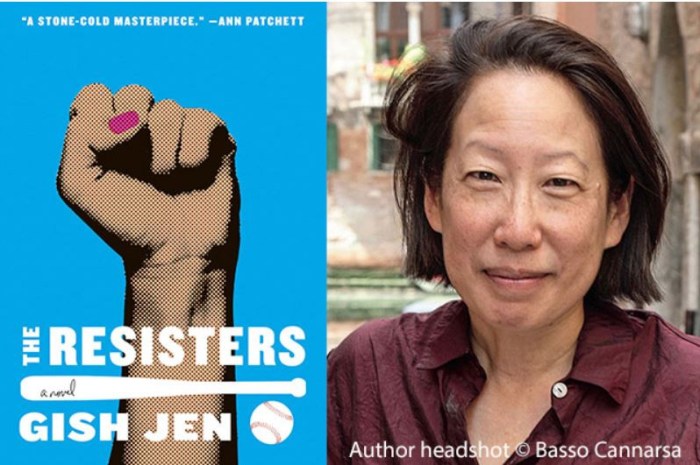In the American Society by Gish Jen, the narrative unfolds in a compelling and distinctive manner, drawing readers into a story that promises to be both engaging and uniquely memorable. This novel delves into the complexities of American identity, cultural assimilation, family dynamics, gender roles, and the experiences of immigrants, offering a profound exploration of the human condition.
Through the experiences of Chinese immigrants and their families, Jen deftly examines the challenges and rewards of assimilation, the conflicts between traditional values and American ideals, and the enduring power of family ties. The novel’s nuanced portrayal of gender roles and the experiences of women in a patriarchal society further enriches its exploration of the complexities of human relationships.
American Identity

In the American society by Gish Jen, the complexities of American identity are portrayed through the experiences of characters who navigate their cultural heritage and societal expectations. The novel explores the role of assimilation and the challenges of maintaining one’s identity in a new culture.
Cultural Heritage and Societal Expectations
The characters in the novel come from diverse cultural backgrounds and face different challenges in reconciling their heritage with the expectations of American society. For example, the protagonist, a young Chinese-American woman named Ruth Young, struggles to balance her traditional Chinese values with the more individualistic values of her American peers.
She feels pressure to conform to both cultures and often feels like she doesn’t belong to either one.
Assimilation and Identity Maintenance
The novel also explores the role of assimilation in American identity. Some characters, like Ruth’s mother, have assimilated into American culture and have adopted many of its values. Others, like Ruth’s father, have maintained their cultural heritage and have resisted assimilation.
The novel shows that there is no one right way to be American and that individuals can choose to assimilate to varying degrees.
Cultural Assimilation and Conflict

Chinese immigrants face unique challenges and rewards as they navigate American society. They must adapt to a new language, culture, and set of values, while also preserving their own traditions and identities.
One of the most significant challenges for Chinese immigrants is the language barrier. Many arrive in the United States with little or no English proficiency, which can make it difficult to communicate with others, find work, and access essential services.
This can lead to feelings of isolation and frustration.
Cultural Differences
In addition to the language barrier, Chinese immigrants must also navigate a number of cultural differences. These differences can be seen in everything from the way people greet each other to the way they eat their meals. For example, in Chinese culture, it is considered impolite to make direct eye contact with someone who is older or in a position of authority.
However, in American culture, direct eye contact is seen as a sign of respect.
Prejudice
Chinese immigrants have also faced a great deal of prejudice and discrimination in the United States. This prejudice can range from subtle forms, such as being treated differently in stores or restaurants, to more overt forms, such as hate crimes.
Prejudice can make it difficult for Chinese immigrants to feel like they belong in American society.
Conflicts Between Traditional Chinese Values and American Ideals
Finally, Chinese immigrants must often navigate conflicts between traditional Chinese values and American ideals. For example, in Chinese culture, it is important to respect one’s elders and to put the needs of the family above one’s own. However, in American culture, it is more common to value individualism and self-reliance.
Family and Relationships

In In the American Society, Gish Jen portrays the complex dynamics of Chinese American families. Family ties are paramount, providing a sense of belonging and support in a foreign land. However, maintaining these ties poses challenges as families navigate cultural expectations and the realities of American society.
Parents and Children
Chinese American parents often place high expectations on their children, emphasizing academic achievement and career success. This can create tension between parents and children, who may feel pressured to conform to cultural norms while also seeking their own paths.
The novel explores the generational gap between parents and children. Parents, raised in traditional Chinese values, may struggle to understand the perspectives of their American-born children. Children, on the other hand, may feel torn between their desire for independence and their obligations to their parents.
Siblings
Sibling relationships are also shaped by cultural expectations. Older siblings are often expected to take on parental roles, supporting and guiding their younger siblings. However, this can lead to resentment and conflict, as older siblings may feel burdened by their responsibilities.
The novel also examines the challenges of maintaining sibling relationships across geographical distances. As Chinese Americans move to different parts of the country, siblings may find it difficult to stay connected and maintain their close bonds.
Spouses, In the american society by gish jen
Marital relationships in Chinese American families are often influenced by traditional gender roles. Men are expected to be the breadwinners, while women are responsible for domestic duties and childcare. This can lead to power imbalances and tension within relationships.
The novel explores the challenges of intercultural marriages. Chinese Americans who marry non-Chinese partners may face cultural misunderstandings and prejudice, which can put strain on their relationships.
Gender and Social Roles: In The American Society By Gish Jen

In the American Society, Gish Jen delves into the intricate portrayal of gender roles, exploring the ways in which Chinese and American cultural expectations shape the experiences of male and female characters. The novel highlights the challenges faced by women in a patriarchal society and the strategies they employ to navigate these constraints.
Chinese Cultural Expectations
Chinese cultural expectations emphasize traditional gender roles, with men expected to be the breadwinners and protectors, while women are relegated to domestic duties and childrearing. This is evident in the experiences of characters like Monty and his wife, Shirley. Monty, a successful doctor, embodies the traditional Chinese male role, while Shirley struggles to find fulfillment beyond her domestic responsibilities.
American Cultural Expectations
American cultural expectations, on the other hand, offer women greater opportunities for education and career advancement. This is reflected in the experiences of characters like Helen and Becky. Helen, a successful businesswoman, represents the American ideal of female empowerment, while Becky, a stay-at-home mom, grapples with the challenges of balancing her family and personal aspirations.
Challenges Faced by Women
The novel highlights the challenges faced by women in a patriarchal society, including limited career opportunities, societal pressure to conform to traditional gender roles, and the burden of domestic responsibilities. Women like Shirley and Becky struggle to find their place in a society that often undervalues their contributions.
Navigating Challenges
Despite these challenges, the novel also explores the ways in which women navigate and resist traditional gender roles. Helen, for example, defies societal expectations by pursuing a successful career and remaining unmarried. Becky, on the other hand, finds fulfillment in her role as a mother while also pursuing her own interests.
Immigration and Displacement
In the American Society by Gish Jen delves into the intricate experiences of immigrants as they navigate the challenges of leaving their home countries and starting new lives in a foreign land. The novel explores the themes of displacement, loss, and the search for belonging.
Challenges of Immigration
- Leaving behind familiar surroundings, culture, and relationships
- Adapting to a new language, customs, and social norms
- Facing discrimination, prejudice, and xenophobia
- Economic and financial struggles in a new country
- Navigating complex immigration laws and policies
Displacement and Loss
Immigration often involves a sense of displacement and loss. Immigrants may feel disconnected from their home country and culture while struggling to fully integrate into their new society. They may experience grief over lost relationships, traditions, and a sense of belonging.
Search for Belonging
Despite the challenges, immigrants often embark on a search for belonging in their new country. They may form new relationships, create new communities, and engage in activities that connect them to their heritage and the wider society.
Literary Techniques

Gish Jen’s “In the American Society” is a multifaceted novel that employs various literary techniques to convey its themes and explore the complexities of Asian American identity. Jen’s skillful use of symbolism, imagery, and foreshadowing creates a rich and evocative narrative that enhances the reader’s understanding of the characters’ experiences and struggles.
Symbolism
Throughout the novel, Jen uses symbolism to convey abstract concepts and ideas. For example, the character of Monty’s hair represents his struggle to assimilate into American culture. Initially, Monty’s hair is long and black, symbolizing his Chinese heritage. However, as he becomes more Americanized, he cuts his hair shorter and dyes it blond, representing his desire to conform to Western beauty standards.
Imagery
Jen’s use of vivid imagery creates a sensory experience for the reader, immersing them in the world of the novel. Through detailed descriptions of settings, characters, and events, she evokes emotions and conveys the characters’ inner struggles. For example, the description of the “yellow river” in the opening chapter symbolizes the cultural divide between Chinese immigrants and their American-born children.
Foreshadowing
Jen skillfully employs foreshadowing to create suspense and build anticipation for future events. Early in the novel, she introduces subtle hints and clues that suggest the impending conflicts and challenges that the characters will face. For example, the mention of Monty’s “bad luck” foreshadows the tragic events that will befall him later in the story.
Narrative Structure
The narrative structure of “In the American Society” contributes significantly to the novel’s themes. Jen uses multiple perspectives and timelines to explore the experiences of different characters, allowing the reader to gain a comprehensive understanding of the complex dynamics within the Asian American community.
The non-linear structure reflects the fragmented nature of the characters’ identities and the challenges they face in navigating two cultures.
Q&A
What is the main theme of In the American Society?
The main theme of In the American Society is the complexities of American identity, particularly for immigrants and their families.
How does Gish Jen explore the challenges of cultural assimilation in the novel?
Jen explores the challenges of cultural assimilation through the experiences of Chinese immigrants, who must navigate language barriers, cultural differences, and prejudice.
What is the significance of family in In the American Society?
Family is central to In the American Society, as it provides a source of support and stability for immigrants in a new country.